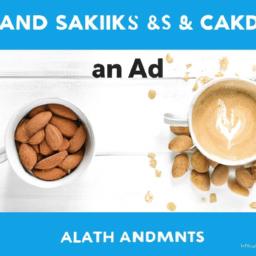Oat Milk vs. Almond Milk: Which Elevates Your Coffee Experience?
Picking the ideal milk for your coffee often feels like a crucial choice that shapes your daily ritual. Should you go for oat milk or almond milk? Both are popular plant-based options, but how do they truly measure up in your cup? At How To Cook Gourmet, we’ve conducted thorough comparisons to help you pick the milk that complements your coffee perfectly.
The Milk Matchup: Oat Milk or Almond Milk – Which Best Suits Your Coffee?
Deciding between oat and almond milk in coffee is akin to choosing a perfect pairing. Each offers distinct qualities – oat milk is renowned for its rich, creamy texture and slightly sweet finish, creating a luscious mouthfeel that harmonizes well with coffee’s robustness. In contrast, almond milk provides a lighter body with subtle nutty overtones that can add a gentle layer of complexity without overwhelming the brew.
Texture is often the decisive factor. Oat milk froths beautifully, ideal for creamy lattes and cappuccinos, whereas almond milk can sometimes separate or become grainy when heated, making it a better option for cold brews or lighter coffee drinks.
| Feature | Oat Milk | Almond Milk |
|---|---|---|
| Mouthfeel | Rich and creamy | Light and delicate |
| Flavor Profile | Sweet with grainy notes | Nutty and subtle |
| Frothing Ability | Superior | Moderate |
| Calories (per cup) | Approx. 120 | Approx. 30 |
| Environmental Footprint | Moderate water, low land use | High water, moderate land use |
Many health enthusiasts prefer oat milk for its fiber content and vitamins, but almond milk’s lower calorie count appeals to those watching intake. From an environmental viewpoint, oat cultivation requires significantly less water than almonds, making it a smaller ecological burden. So, are you prioritizing taste, nutrition, or sustainability today?
Heating Impact: How Texture Shifts When Milk Meets Heat
The way milk reacts to heat can make or break your coffee’s texture and overall enjoyment. Oat milk maintains a seamless, silky consistency even when steamed or heated vigorously, forming the creamy foam baristas love to create latte art. Almond milk, while versatile, can struggle under high temperatures, leading to separation or a slight grainy mouthfeel if not handled carefully.
| Milk Type | Heat Resistance | Post-Heated Texture | Ideal Use |
|---|---|---|---|
| Oat Milk | High | Velvety smooth foam | Lattes, cappuccinos |
| Almond Milk | Medium | Thin, may separate | Iced coffee, light froth drinks |
- Oat milk’s resilience to heat ensures a rich, consistent foam texture.
- Almond milk requires gentle heating to maintain smoothness and avoid curdling.
- Think about the texture you prefer in your coffee: ultra-creamy or refreshingly light?
Flavor Interaction: How Each Milk Influences Coffee’s Taste
The interplay between milk and coffee profoundly affects your drinking experience. Oat milk’s mild sweetness and creaminess tend to amplify the coffee’s natural depth without overpowering it, akin to adding a cozy warmth. Almond milk imparts a delicate nuttiness. However, depending on the brand or preparation, this flavor can be more pronounced, sometimes masking subtle coffee notes.
| Milk | Flavor Effect | Texture | Sweetness Level |
|---|---|---|---|
| Oat Milk | Enhances coffee’s richness | Creamy, smooth | Lightly sweet |
| Almond Milk | Adds mild nutty undertones | Thin, sometimes watery | Subtle sweetness |
Those who prefer bold, full-bodied coffee usually favor oat milk’s seamless integration, while almond milk suits fans of a lighter, more nuanced flavor profile. Much like choosing between a rich caramel dessert or a crisp fruit tart, your milk choice shapes the sensory journey of your cup.
Health Benefits and Allergies: Nutritional Insights on Both Milks
Interested in adding a health boost to your coffee? Understanding the nutritional nuances helps you align your choice with your wellness goals.
Vitamin and Nutrient Content
- Oat Milk: Enriched versions often deliver vitamin B12 and vitamin D, essential for energy and bone health.
- Almond Milk: Naturally rich in vitamin E, a powerful antioxidant that supports skin and immune health.
| Milk | Calories (per cup) | Key Nutrients | Potential Allergens |
|---|---|---|---|
| Oat Milk | ~120 | B12, D, fiber | Gluten (occasionally) |
| Almond Milk | ~30 | Vitamin E | Tree nuts |
If you monitor calorie intake, almond milk offers a lighter option. But for fiber-rich nutrition and a more filling choice, oat milk is compelling. Also, allergic sensitivities are crucial to consider-tree nut allergies exclude almond milk, while gluten-intolerant individuals might avoid some oat milks.
Foaming Potential: Which Milk Creates the Creamiest Coffee Froth?
Foam isn’t only aesthetic – it’s key to the texture and enjoyment of specialty coffee drinks. Oat milk is widely favored for its ability to create thick, creamy, and stable foam, thanks to its natural starches and proteins. Almond milk can froth, but its light structure results in shorter-lived, less dense foam.
- Oat milk: Produces dense, velvety foam ideal for latte art and cappuccinos.
- Almond milk: Creates an airy, light foam that dissipates quickly.
| Milk | Foam Thickness | Foam Longevity | Best Use |
|---|---|---|---|
| Oat Milk | Thick and creamy | Long-lasting | Rich cappuccinos, barista-style lattes |
| Almond Milk | Light and bubbly | Quickly fades | Light froths for iced or simple coffees |
Environmental Considerations: How Your Milk Choice Affects the Planet
In today’s eco-conscious world, the sustainability of oat versus almond milk often influences consumer choices. Almond farming is notorious for its high water consumption – it takes roughly 920 gallons of water to produce just one liter of almond milk. Conversely, oat milk’s water footprint is significantly smaller, around 48 gallons per liter.
Land usage is another factor. Oats typically grow in cooler climates and require less agricultural land compared to almond orchards, predominantly concentrated in water-stressed regions.
| Aspect | Almond Milk | Oat Milk |
|---|---|---|
| Water Use (gallons/liter) | 920 | 48 |
| Land Usage | Higher | Lower |
| Carbon Emissions | Moderate | Lower |
Choosing oat milk over almond milk often aligns with sustainable consumption goals. It reduces water consumption, land demand, and carbon emissions, making you a greener coffee drinker.
Cost Comparison: Which Milk Stretches Your Coffee Budget Further?
Affordability is a key consideration for many coffee fans. On average, oat milk cartons tend to be priced slightly higher but also offer more servings per container, decreasing the cost per cup in the long run. Almond milk is often less expensive upfront but might require more frequent purchases.
| Milk Type | Average Price per Carton | Servings (per carton) | Approximate Cost per Serving |
|---|---|---|---|
| Oat Milk | $3.50 | 8 | $0.44 |
| Almond Milk | $3.00 | 6 | $0.50 |
Consider buying in bulk or seeking sales to maximize your value, whichever milk you prefer. Your coffee routine can benefit both your palate and your wallet with a little savvy shopping.
Making the Final Choice: Which Plant Milk Should Crown Your Coffee?
Ultimately, the best milk for your morning brew boils down to your personal taste, texture preference, dietary needs, and environmental values.
| Milk | Texture | Flavor | Best Use | Sustainability Notes |
|---|---|---|---|---|
| Oat Milk | Creamy and smooth | Mildly sweet and hearty | Complementing rich coffee drinks | Lower water use, reduced emissions |
| Almond Milk | Light and thin | Nutty, crisp | Ideal for black or iced coffee | High water demand, moderate emissions |
Whether you lean into the creamy embrace of oat milk or opt for the refreshing nuttiness of almond milk, your coffee ritual stands to gain a new dimension. We encourage experimenting – try both and see how each transforms your daily brew. Your taste buds and values will guide your ultimate pick.
Frequently Asked Questions: Oat Milk and Almond Milk in Coffee
- Which milk tastes better with coffee?
- Flavor is subjective. Oat milk offers creaminess and subtle sweetness that enhance coffee richness, whereas almond milk adds a gentle nutty note. Choose based on whether you prefer smooth or mildly textured flavors.
- Does oat or almond milk froth better?
- Oat milk excels at creating dense, stable foam perfect for lattes and cappuccinos. Almond milk foams lighter and dissipates faster but works well for breezier coffee styles.
- Are there noticeable health differences?
- Oat milk provides more carbs and fiber, often fortified with vitamins B12 and D. Almond milk is lower in calories but lacks significant protein. Allergy considerations are also important.
- How do they behave when heated?
- Oat milk withstands heat well, maintaining smooth texture. Almond milk can curdle if overheated or combined with acidic coffee.
- Which milk has a smaller environmental footprint?
- Oat milk is more sustainable, consuming far less water and land, as well as generating fewer carbon emissions compared to almond milk production.
- Are there allergy concerns?
- Almond milk should be avoided by individuals with nut allergies. Oat milk is generally safe but check for gluten content if sensitive.
- Does oat milk make coffee sweet?
- Oat milk contains natural sugars that lightly sweeten coffee, while almond milk offers a subtler sweetness.
- Which masks coffee bitterness better?
- The creamy texture of oat milk often mellows out coffee’s bitterness more effectively than almond milk’s lighter profile.
Conclusion: Craft Your Perfect Coffee Moment
At How To Cook Gourmet, we believe there’s no one-size-fits-all answer-both oat and almond milk bring unique delights to your coffee cup. Oat milk’s creamy texture embodies comfort and coziness, transforming drinks into rich, satisfying experiences. Almond milk imparts a gentle, nutty freshness, making it excellent for lighter or iced beverages.
Consider your taste preference, nutritional needs, environmental values, and budget when selecting your milk companion. Let your coffee cup reflect what feels right for you – whether that’s a velvety hug or a crisp, nutty whisper.
Ready to elevate your coffee ritual? Pour, sip, and savor the milk that speaks to your morning mood.




